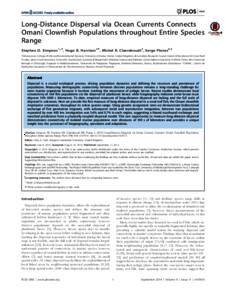وثيقة
Long-distance dispersal via ocean currents connects Omani clownfish populations throughout entire species range.
المعرف
DOI: 10.1371/journal.pone.0107610
المساهمون
الناشر
Public Library of Science.
ميلادي
2014-09
اللغة
الأنجليزية
الموضوع
الملخص الإنجليزي
Dispersal is a crucial ecological process, driving population dynamics and defining the structure and persistence of populations. Measuring demographic connectivity between discreet populations remains a long-standing challenge for most marine organisms because it involves tracking the movement of pelagic larvae. Recent studies demonstrate local connectivity of reef fish populations via the dispersal of planktonic larvae, while biogeography indicates some larvae must disperse 100-1000 s kilometres. To date, empirical measures of long-distance dispersal are lacking and the full scale of dispersal is unknown. Here we provide the first measure of long-distance dispersal in a coral reef fish, the Omani clownfish Amphiprion omanensis, throughout its entire species range. Using genetic assignment tests we demonstrate bidirectional exchange of first generation migrants, with subsequent social and reproductive integration, between two populations separated by over 400 km. Immigration was 5.4% and 0.7% in each region, suggesting a biased southward exchange, and matched predictions from a physically-coupled dispersal model. This rare opportunity to measure long-distance dispersal demonstrates connectivity of isolated marine populations over distances of 100 s of kilometres and provides a unique insight into the processes of biogeography, speciation and adaptation.
المجموعة
ISSN
1932-6203
URL المصدر
قالب العنصر
مقالات الدوريات

